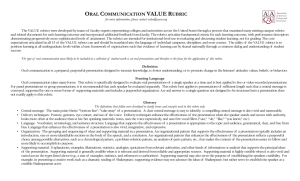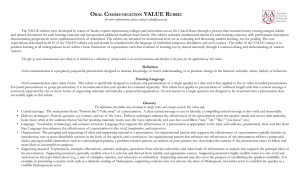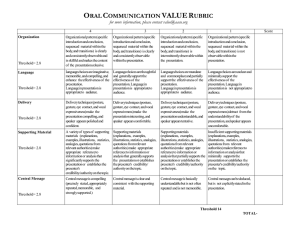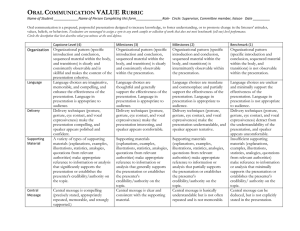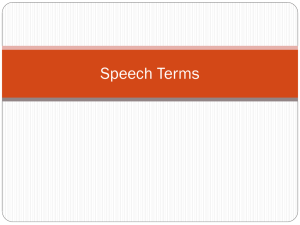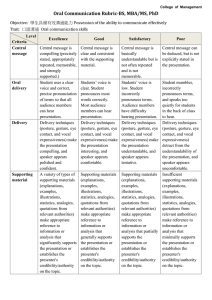O C VALUE R
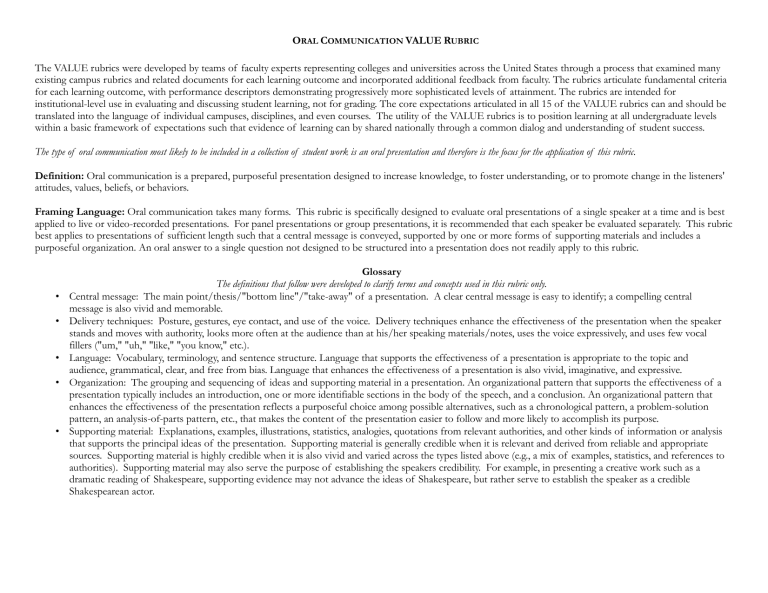
O RAL C OMMUNICATION VALUE R UBRIC
The VALUE rubrics were developed by teams of faculty experts representing colleges and universities across the United States through a process that examined many existing campus rubrics and related documents for each learning outcome and incorporated additional feedback from faculty. The rubrics articulate fundamental criteria for each learning outcome, with performance descriptors demonstrating progressively more sophisticated levels of attainment. The rubrics are intended for institutional-level use in evaluating and discussing student learning, not for grading. The core expectations articulated in all 15 of the VALUE rubrics can and should be translated into the language of individual campuses, disciplines, and even courses. The utility of the VALUE rubrics is to position learning at all undergraduate levels within a basic framework of expectations such that evidence of learning can by shared nationally through a common dialog and understanding of student success.
The type of oral communication most likely to be included in a collection of student work is an oral presentation and therefore is the focus for the application of this rubric.
Definition: Oral communication is a prepared, purposeful presentation designed to increase knowledge, to foster understanding, or to promote change in the listeners' attitudes, values, beliefs, or behaviors.
Framing Language: Oral communication takes many forms. This rubric is specifically designed to evaluate oral presentations of a single speaker at a time and is best applied to live or video-recorded presentations. For panel presentations or group presentations, it is recommended that each speaker be evaluated separately. This rubric best applies to presentations of sufficient length such that a central message is conveyed, supported by one or more forms of supporting materials and includes a purposeful organization. An oral answer to a single question not designed to be structured into a presentation does not readily apply to this rubric.
Glossary
The definitions that follow were developed to clarify terms and concepts used in this rubric only.
• Central message: The main point/thesis/"bottom line"/"take-away" of a presentation. A clear central message is easy to identify; a compelling central message is also vivid and memorable.
• Delivery techniques: Posture, gestures, eye contact, and use of the voice. Delivery techniques enhance the effectiveness of the presentation when the speaker stands and moves with authority, looks more often at the audience than at his/her speaking materials/notes, uses the voice expressively, and uses few vocal fillers ("um," "uh," "like," "you know," etc.).
• Language: Vocabulary, terminology, and sentence structure. Language that supports the effectiveness of a presentation is appropriate to the topic and audience, grammatical, clear, and free from bias. Language that enhances the effectiveness of a presentation is also vivid, imaginative, and expressive.
• Organization: The grouping and sequencing of ideas and supporting material in a presentation. An organizational pattern that supports the effectiveness of a presentation typically includes an introduction, one or more identifiable sections in the body of the speech, and a conclusion. An organizational pattern that enhances the effectiveness of the presentation reflects a purposeful choice among possible alternatives, such as a chronological pattern, a problem-solution pattern, an analysis-of-parts pattern, etc., that makes the content of the presentation easier to follow and more likely to accomplish its purpose.
• Supporting material: Explanations, examples, illustrations, statistics, analogies, quotations from relevant authorities, and other kinds of information or analysis that supports the principal ideas of the presentation. Supporting material is generally credible when it is relevant and derived from reliable and appropriate sources. Supporting material is highly credible when it is also vivid and varied across the types listed above (e.g., a mix of examples, statistics, and references to authorities). Supporting material may also serve the purpose of establishing the speakers credibility. For example, in presenting a creative work such as a dramatic reading of Shakespeare, supporting evidence may not advance the ideas of Shakespeare, but rather serve to establish the speaker as a credible
Shakespearean actor.
Definition:Oral communication is a prepared, purposeful presentation designed to increase knowledge, to foster understanding, or to promote change in the listeners' attitudes, values, beliefs, or behaviors. Evaluators are encouraged to assign a zero to any work sample or collection of work that does not meet benchmark (cell one) level performance.
Capstone 4 Milestones 3 2 Benchmark1
Organization Organizational pattern (specific introduction and conclusion, sequenced material within the body, and transitions) is clearly and consistently observable and is skillful and makes the content of the presentation cohesive.
Organizational pattern (specific introduction and conclusion, sequenced material within the body, and transitions) is clearly and consistently observable within the presentation.
Organizational pattern (specific introduction and conclusion, sequenced material within the body, and transitions) is intermittently observable within the presentation.
Organizational pattern (specific introduction and conclusion, sequenced material within the body, and transitions) is not observable within the presentation.
Language
Delivery
Supporting
Material
Language choices are imaginative, memorable, and compelling, and enhance the effectiveness of the presentation. Language in presentation is appropriate to audience.
Language choices are thoughtful and generally support the effectiveness of the presentation. Language in presentation is appropriate to audience.
Language choices are mundane and commonplace and partially support the effectiveness of the presentation. Language in presentation is appropriate to audience.
Delivery techniques (posture, gesture, eye contact, and vocal expressiveness) make the presentation compelling, and speaker appears polished and confident.
A variety of types of supporting materials (explanations, examples, illustrations, statistics, analogies, quotations from relevant authorities) make appropriate reference to information or analysis that significantly supports the presentation or establishes the presenter's credibility/authority on the topic.
Delivery techniques (posture, gesture, eye contact, and vocal expressiveness) make the presentation interesting, and speaker appears comfortable.
Supporting materials (explanations, examples, illustrations, statistics, analogies, quotations from relevant authorities) make appropriate reference to information or analysis that generally supports the presentation or establishes the presenter's credibility/authority on the topic.
Delivery techniques (posture, gesture, eye contact, and vocal expressiveness) make the presentation understandable, and speaker appears tentative.
Supporting materials
(explanations, examples, illustrations, statistics, analogies, quotations from relevant authorities) make appropriate reference to information or analysis that partially supports the presentation or establishes the presenter's credibility/authority on the topic.
Language choices are unclear and minimally support the effectiveness of the presentation. Language in presentation is not appropriate to audience.
Delivery techniques (posture, gesture, eye contact, and vocal expressiveness) detract from the understandability of the presentation, and speaker appears uncomfortable.
Insufficient supporting materials
(explanations, examples, illustrations, statistics, analogies, quotations from relevant authorities) make reference to information or analysis that minimally supports the presentation or establishes the presenter's credibility/authority on the topic.
Central
Message
Central message is compelling
(precisely stated, appropriately repeated, memorable, and strongly supported.)
Central message is clear and consistent with the supporting material.
Central message is basically understandable but is not often repeated and is not memorable.
Central message can be deduced, but is not explicitly stated in the presentation.
